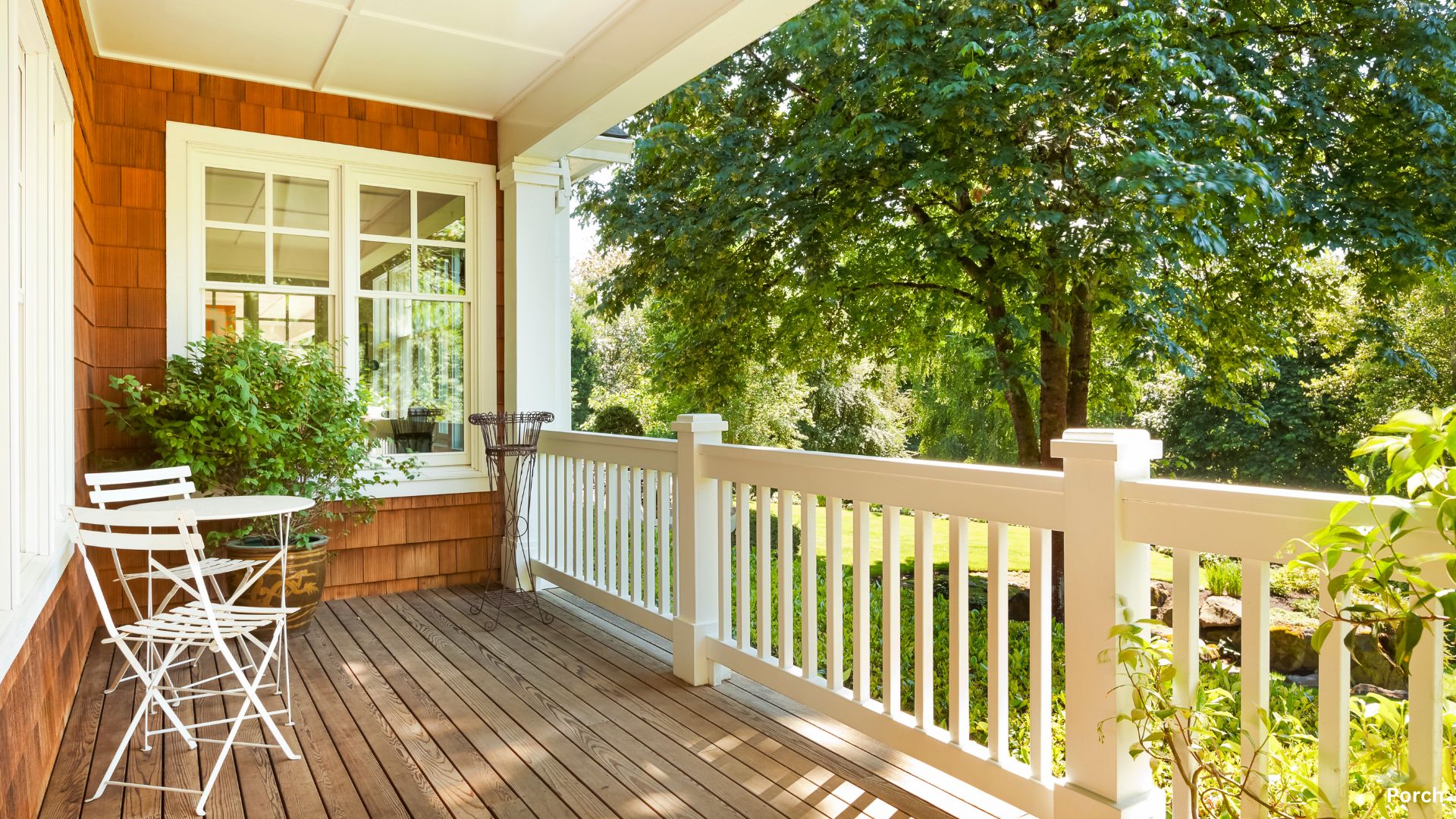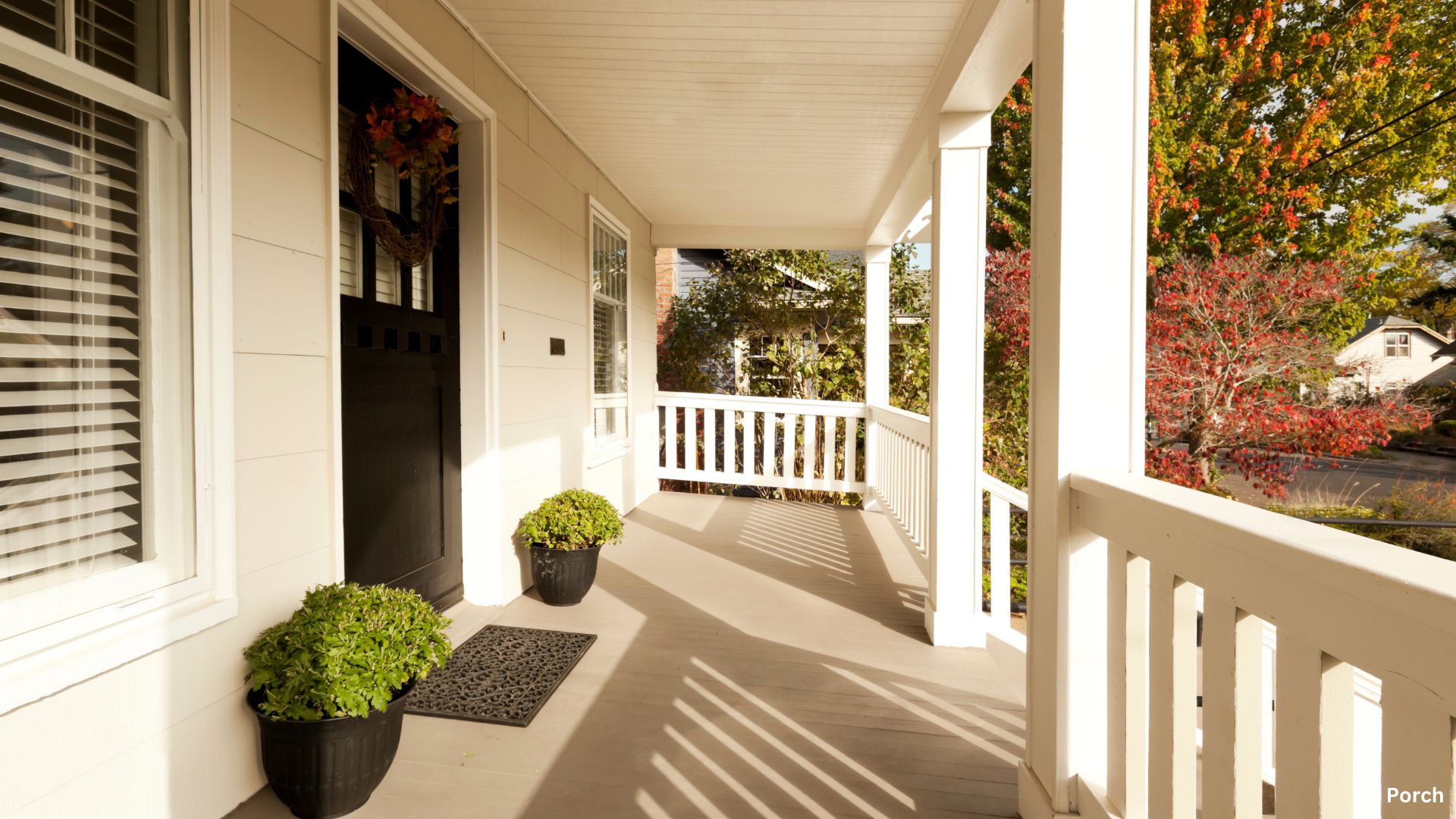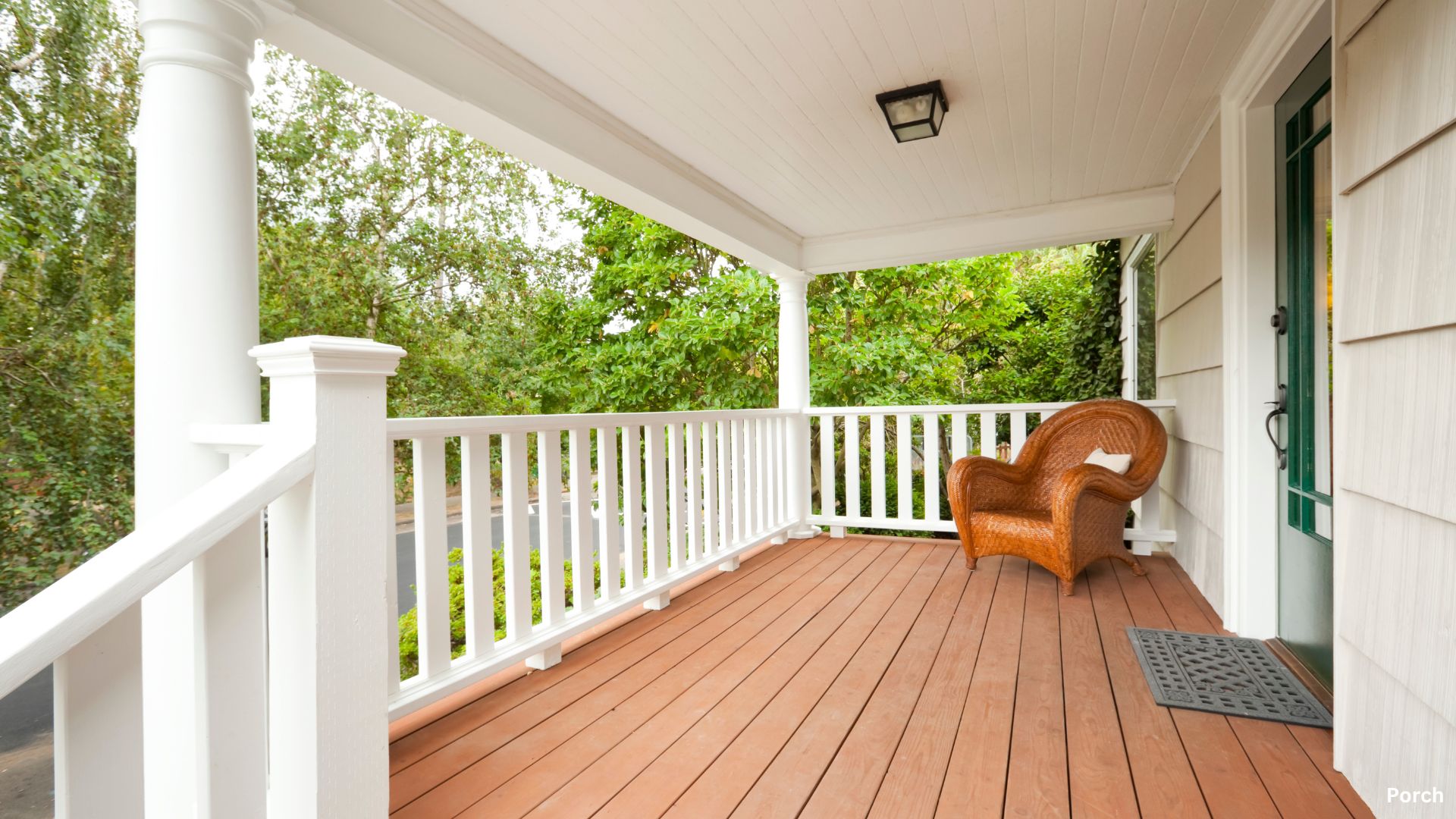Porches are an iconic feature that enhances a home’s charm and functionality. They come in various styles, from classic front porches to cozy screened retreats, offering versatile outdoor spaces for relaxation, entertaining, and connecting with neighbors.

Discover everything about porches in this comprehensive guide: types, design, cost, and benefits. | Image from Canva
Whether you’re considering adding a new porch or remodeling an existing one, this comprehensive guide will help you understand the different types, design elements, costs, and benefits of porches. Let’s explore how to make the most of these timeless outdoor living spaces!
Types of Porches
Front Porches

Canva image
Front porches are a welcoming feature, often showcasing architectural styles like Colonial or Victorian. They encourage social interaction with neighbors and add significant curb appeal. For example, a Colonial-style front porch can beautifully complement a symmetrical facade, creating a charming entrance.
Back Porches
Back porches provide a private retreat for relaxation or entertaining guests. They differ from front porches in their secluded nature and often include features like dining areas. Imagine a cozy back porch overlooking a lush garden, perfect for morning coffee or evening dinners.
Screened Porches
Screened porches offer protection from insects and weather, making them ideal in warmer climates. They typically feature mesh screens and sometimes glass panels. For instance, a screened porch can serve as an all-weather space, enabling year-round enjoyment.
Wraparound Porches
Wraparound porches extend around multiple sides of the house, providing panoramic views. Popular in historical designs, they remain a favorite for creating seamless indoor-outdoor transitions. Picture a wraparound porch circling a Victorian home, offering ample space for relaxing or entertaining.
Sleeping Porches
Sleeping porches, once popular in the early 20th century, were used for cool summer nights. They often feature screened walls and ceiling fans to maintain airflow. Today, their revival includes modern comforts like heaters and stylish furnishings.
Sun Porches (Three-Season and Four-Season Porch)
Three-season porches offer spring-to-fall enjoyment, while four-season porches are usable year-round. Sun porches typically have large windows, providing ample natural light. A three-season porch might have simple screens, while a four-season porch could include heating and cooling systems.
Designing a Porch
Identifying Purpose and Function
Start by determining the porch’s purpose, whether for entertaining guests or relaxing solo. Will it be a dining area, lounge, or play space for kids?
Architectural Styles and Materials
Match the porch style to your home’s architecture and select appropriate materials. For instance, a Craftsman-style porch should feature tapered columns and wooden railings.
Safety and Accessibility Considerations
Include handrails, non-slip surfaces, and ramps for accessibility. Ensure the porch is safe for children, pets, and elderly visitors.
Roofing and Structural Support
Choose the right roofing style, such as gable, shed, or hip roof. Ensure columns and beams offer solid structural support.
Decorating and Furnishing
Furniture Choices
Pick furniture that complements the porch’s style and purpose, like wicker chairs for a coastal vibe or a metal table for modern elegance. Arrange pieces to facilitate conversation and relaxation.
Décor Elements
Add lighting, such as string lights, lanterns, or sconces, to create ambiance. Rugs, plants, and curtains can further enhance the porch’s look and feel.
Seasonal Porch Décor
Adapt your porch décor to the seasons. Use light fabrics and bright colors for summer, pumpkins and warm hues for fall, evergreens and lights for winter, and floral arrangements for spring.

Image from Canva
Cost of Adding and Remodeling a Porch
Cost of Adding a New Porch
On average, adding a basic porch costs between $15,000 and $30,000. This includes expenses for materials, labor, permits, and extras like lighting.
- Materials (e.g., wood, metal, composite): $5,000 – $15,000
- Labor (e.g., carpentry, electrical, plumbing): $5,000 – $10,000
- Permits and Inspection Fees: $500 – $1,500
- Foundation and Structural Support: $2,000 – $5,000
- Roofing: $1,000 – $3,000
- Extras (e.g., lighting, railings, screens): $1,000 – $5,000
Average Cost Range: $15,000 – $30,000
Cost of Remodeling an Existing Porch
Simple repairs might cost around $1,000, while a full remodel could range from $5,000 to $15,000.
Simple Repairs:
-
- Painting/Staining: $500 – $1,000
- Replacing Loose/Broken Boards: $300 – $800
- Repairing/Replacing Screens: $200 – $500
Total Cost of Simple Repairs: $1,000 – $2,000
Full Remodel:
-
- Foundation and Structural Repairs: $1,000 – $3,000
- New Flooring or Decking: $1,500 – $4,000
- Roofing Replacement: $1,000 – $3,000
- New Railings/Columns: $800 – $2,500
- Screen Installation: $500 – $2,000
- Lighting and Electrical: $500 – $1,500
- Furniture and Décor: $700 – $1,500
Total Cost of Full Remodel: $5,000 – $15,000
ROI (Return on Investment) of Adding/Remodeling a Porch
Adding or remodeling porches can increase property value by enhancing curb appeal. A new porch typically offers a 70-90% return on investment. Porch ROI varies by region, with higher returns in areas where outdoor living is popular.
Maintenance and Upkeep
Regular Cleaning and Inspection
Clean porches regularly, and inspect for damage or pests. Wooden porches require special attention to prevent rot and termites.
Painting and Staining
Protect wood porches with paint or stain. Refresh finishes every few years to maintain their appearance.
Repairing Common Issues
Fix loose boards, broken screens, and rust promptly. Prevent future problems by sealing cracks and treating wood.
Benefits of Having a Porch
Increased Property Value
Porches improve curb appeal, positively impacting home appraisals. They create inviting spaces that attract potential buyers.
Health and Wellbeing
Porches provide a serene connection to nature, reducing stress and fostering relaxation. They offer a welcoming space for friends and family.
Community Building
Porches foster neighborhood interactions, historically serving as a social hub. They continue to promote a sense of community today.
FAQs Section
What is the difference between a porch and a patio?
A porch is an attached outdoor space, often covered, while a patio is ground-level and typically uncovered.
How much does it cost to build a porch?
Building a porch can range from $15,000 to $30,000, depending on size, materials, and location.
What type of wood is best for porches?
Cedar, redwood, and pressure-treated pine are durable, weather-resistant options for wooden porches.
How can I winterize my porch?
Install storm windows, add weatherproof furniture covers, and use space heaters or electric fireplaces.
Are porches safe for children and pets?
Yes, if equipped with safety features like handrails, non-slip surfaces, and secure gates.
How long does a porch typically last?
A well-constructed porch can last 20-30 years with proper maintenance. The lifespan depends on the materials used and the level of upkeep.
Can I add a porch to an existing home?
Yes, many homeowners choose to add a porch as a home improvement project. It’s important to check with a contractor to ensure the existing structure can support the addition.






